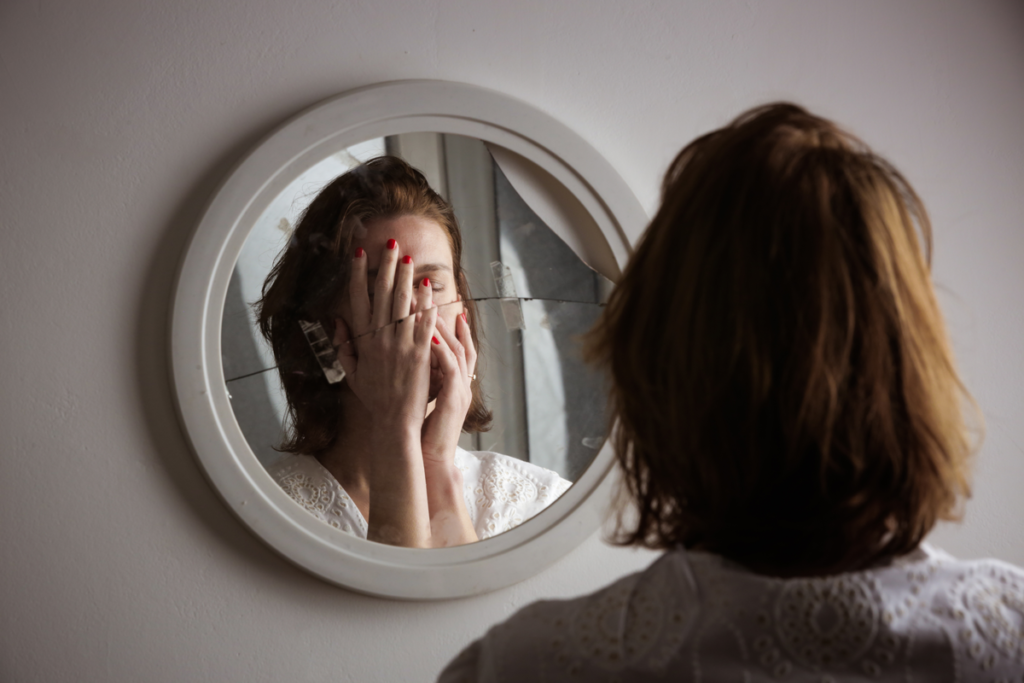Zoom Dysmorphia: The Distortion of Self-Image

The pandemic generated many changes in our lifestyle. For example, work and classes were moved to digital platforms. Consequently, virtual contact with others became far more ingrained and we spent more time in video conferences. This meant that we had the opportunity to observe our image more often than before.
However, those long hours we spent looking at ourselves on the screen produced some major changes and disturbing insights into how we were viewing ourselves. This is how the phenomenon known as Zoom dysmorphia came about and started to affect how we related to our appearance.
Zoom dysmorphia
Zoom dysmorphia is the inability to stop thinking about one or more perceived flaws in our appearance after looking at our image for some time. The experience can make us feel anxious about attending a video call. In fact, we try to look perfect and tend to over-focus on our face on the screen, finding imperfections in it.
This kind of body dysmorphia is characterized by a preoccupation with our image projected on a digital screen. In recent years, and as a consequence of the increase in video calls and virtual meetings, these types of concerns have increased.
During the pandemic, dermatologist, Dr. Shadi Kourosh, noted that some of her patients wanted to make changes to their appearance, including surgery. She became concerned that the time they were spending on camera was affecting their perceptions of their appearance.
A survey conducted with 134 dermatology care providers found that 56.7 percent of the sample reported an increase in patients seeking cosmetic consultations compared to before the pandemic. 86.4 percent of these providers noted that patients cited video conferencing as the reason for seeking care.
Regarding the areas of the body that patients were concerned about, 80 percent of the respondents stated that patients focused on the forehead. 78 percent reported that they focused on the periocular areas. Other regions that received a lot of attention were wrinkles on the upper part of the face, dark circles under the eyes, dark spots on the face, and sagging of the neck.

Why are cameras so disturbing?
Rice, Graber, and Kourosh (2020) argue that, during real-life conversations, we don’t observe our faces speaking and expressing emotions. Furthermore, we don’t compare our faces side by side, as we do in video calls. Additionally, cameras can distort video quality and create an inaccurate representation of what we actually look like.
Research has demonstrated that when people take photos of themselves 12 inches away (selfies) their nose size appears to increase by 30 percent in men and 29 percent in women. In contrast, an image taken from five feet away makes virtually no difference in perceived size.
Thus, the image that’s projected on the cameras shows us an appearance of ourselves that’s different from how we really are. Our image is filtered and we begin to notice our imperfections. In turn, we magnify and generalize these perceived flaws. This leads us to become increasingly concerned about them and how others see us.
The relationship with self-esteem
When we possess low self-esteem, we tend to externalize our worth. This means we tend to depend on the people around us in order to feel good about ourselves and to feel accepted, recognized, and worthy of love. In other words, we don’t value ourselves for who we really are but through others.
However, when we deposit our value outside of ourselves, it starts to depend on the image we project. Consequently, we make an attempt to build a pleasant, beautiful, perfect image, capable of earning the appreciation of others. It’s on this image that we measure our own value.
The perception of our body and the feelings associated with it influences not only our self-concept but also our self-esteem. Therefore, the influence between self-esteem and body image is mutual. This is clearly demonstrated in Zoom dysmorphia. There’s a continuous devaluation of body image, more specifically that of the face. It affects the way we feel about ourselves and also the value we attribute to ourselves.

Strategies to avoid Zoom dysmorphia
As a rule, you can follow these guidelines:
- Try not to continually look at yourself on the phone’s screen or camera. You might want to disable the camera. However, if this isn’t possible, you can cover up the box where your image appears with a piece of paper.
- Change your perspective and put yourself in other people’s shoes. Do you really think they’ve met with you to analyze and tell you about your imperfections? That’s highly unlikely. They’re probably simply interested in the conversation and its content.
- Remember that the other participants, just like you, are more aware of themselves and the image they’re projecting than the appearance of others. Bear in mind that there are many people who suffer from body image issues. Indeed, the person you’re speaking to might well be one of them.
Finally, continuous exposure to your image on digital platforms or devices can end up altering the perception you have of your body. It might make you feel dissatisfied, imperfect, and worthless. For this reason, it’s important to remember that the way you see yourself and how others see you go way beyond what a screen can ever show you.
The pandemic generated many changes in our lifestyle. For example, work and classes were moved to digital platforms. Consequently, virtual contact with others became far more ingrained and we spent more time in video conferences. This meant that we had the opportunity to observe our image more often than before.
However, those long hours we spent looking at ourselves on the screen produced some major changes and disturbing insights into how we were viewing ourselves. This is how the phenomenon known as Zoom dysmorphia came about and started to affect how we related to our appearance.
Zoom dysmorphia
Zoom dysmorphia is the inability to stop thinking about one or more perceived flaws in our appearance after looking at our image for some time. The experience can make us feel anxious about attending a video call. In fact, we try to look perfect and tend to over-focus on our face on the screen, finding imperfections in it.
This kind of body dysmorphia is characterized by a preoccupation with our image projected on a digital screen. In recent years, and as a consequence of the increase in video calls and virtual meetings, these types of concerns have increased.
During the pandemic, dermatologist, Dr. Shadi Kourosh, noted that some of her patients wanted to make changes to their appearance, including surgery. She became concerned that the time they were spending on camera was affecting their perceptions of their appearance.
A survey conducted with 134 dermatology care providers found that 56.7 percent of the sample reported an increase in patients seeking cosmetic consultations compared to before the pandemic. 86.4 percent of these providers noted that patients cited video conferencing as the reason for seeking care.
Regarding the areas of the body that patients were concerned about, 80 percent of the respondents stated that patients focused on the forehead. 78 percent reported that they focused on the periocular areas. Other regions that received a lot of attention were wrinkles on the upper part of the face, dark circles under the eyes, dark spots on the face, and sagging of the neck.

Why are cameras so disturbing?
Rice, Graber, and Kourosh (2020) argue that, during real-life conversations, we don’t observe our faces speaking and expressing emotions. Furthermore, we don’t compare our faces side by side, as we do in video calls. Additionally, cameras can distort video quality and create an inaccurate representation of what we actually look like.
Research has demonstrated that when people take photos of themselves 12 inches away (selfies) their nose size appears to increase by 30 percent in men and 29 percent in women. In contrast, an image taken from five feet away makes virtually no difference in perceived size.
Thus, the image that’s projected on the cameras shows us an appearance of ourselves that’s different from how we really are. Our image is filtered and we begin to notice our imperfections. In turn, we magnify and generalize these perceived flaws. This leads us to become increasingly concerned about them and how others see us.
The relationship with self-esteem
When we possess low self-esteem, we tend to externalize our worth. This means we tend to depend on the people around us in order to feel good about ourselves and to feel accepted, recognized, and worthy of love. In other words, we don’t value ourselves for who we really are but through others.
However, when we deposit our value outside of ourselves, it starts to depend on the image we project. Consequently, we make an attempt to build a pleasant, beautiful, perfect image, capable of earning the appreciation of others. It’s on this image that we measure our own value.
The perception of our body and the feelings associated with it influences not only our self-concept but also our self-esteem. Therefore, the influence between self-esteem and body image is mutual. This is clearly demonstrated in Zoom dysmorphia. There’s a continuous devaluation of body image, more specifically that of the face. It affects the way we feel about ourselves and also the value we attribute to ourselves.

Strategies to avoid Zoom dysmorphia
As a rule, you can follow these guidelines:
- Try not to continually look at yourself on the phone’s screen or camera. You might want to disable the camera. However, if this isn’t possible, you can cover up the box where your image appears with a piece of paper.
- Change your perspective and put yourself in other people’s shoes. Do you really think they’ve met with you to analyze and tell you about your imperfections? That’s highly unlikely. They’re probably simply interested in the conversation and its content.
- Remember that the other participants, just like you, are more aware of themselves and the image they’re projecting than the appearance of others. Bear in mind that there are many people who suffer from body image issues. Indeed, the person you’re speaking to might well be one of them.
Finally, continuous exposure to your image on digital platforms or devices can end up altering the perception you have of your body. It might make you feel dissatisfied, imperfect, and worthless. For this reason, it’s important to remember that the way you see yourself and how others see you go way beyond what a screen can ever show you.
All cited sources were thoroughly reviewed by our team to ensure their quality, reliability, currency, and validity. The bibliography of this article was considered reliable and of academic or scientific accuracy.
- ‘I believe it’s a mental health issue’: the rise of Zoom dysmorphia. Disponible en: https://www.theguardian.com/fashion/2021/sep/01/i-believe-its-a-mental-health-issue-the-rise-of-zoom-dysmorphia.
- Rice, S. M., Graber, E., & Kourosh, A. S. (2020). A Pandemic of Dysmorphia: “Zooming” into the Perception of Our Appearance. Facial Plastic Surgery & Aesthetic Medicine, 22(6), 401–402. doi:10.1089/fpsam.2020.0454
- Ramphul, K. (2022). “Zoom Dysmorphia”: the rise of a new issue amidst the pandemic. Acta Bio Medica: Atenei Parmensis, 92(6).
This text is provided for informational purposes only and does not replace consultation with a professional. If in doubt, consult your specialist.







